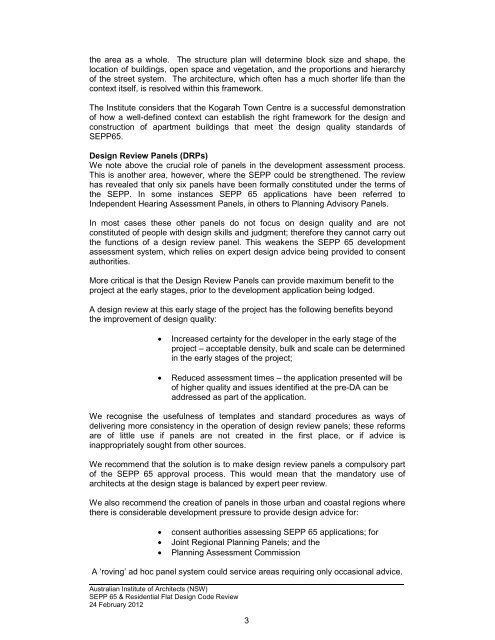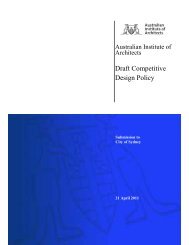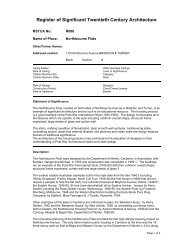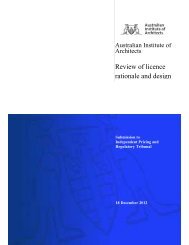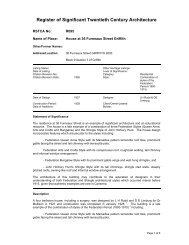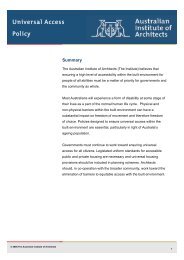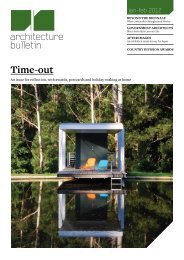SEPP 65 & Residential Flat Design Code Review - Australian ...
SEPP 65 & Residential Flat Design Code Review - Australian ...
SEPP 65 & Residential Flat Design Code Review - Australian ...
Create successful ePaper yourself
Turn your PDF publications into a flip-book with our unique Google optimized e-Paper software.
the area as a whole. The structure plan will determine block size and shape, thelocation of buildings, open space and vegetation, and the proportions and hierarchyof the street system. The architecture, which often has a much shorter life than thecontext itself, is resolved within this framework.The Institute considers that the Kogarah Town Centre is a successful demonstrationof how a well-defined context can establish the right framework for the design andconstruction of apartment buildings that meet the design quality standards of<strong>SEPP</strong><strong>65</strong>.<strong>Design</strong> <strong>Review</strong> Panels (DRPs)We note above the crucial role of panels in the development assessment process.This is another area, however, where the <strong>SEPP</strong> could be strengthened. The reviewhas revealed that only six panels have been formally constituted under the terms ofthe <strong>SEPP</strong>. In some instances <strong>SEPP</strong> <strong>65</strong> applications have been referred toIndependent Hearing Assessment Panels, in others to Planning Advisory Panels.In most cases these other panels do not focus on design quality and are notconstituted of people with design skills and judgment; therefore they cannot carry outthe functions of a design review panel. This weakens the <strong>SEPP</strong> <strong>65</strong> developmentassessment system, which relies on expert design advice being provided to consentauthorities.More critical is that the <strong>Design</strong> <strong>Review</strong> Panels can provide maximum benefit to theproject at the early stages, prior to the development application being lodged.A design review at this early stage of the project has the following benefits beyondthe improvement of design quality:• Increased certainty for the developer in the early stage of theproject – acceptable density, bulk and scale can be determinedin the early stages of the project;• Reduced assessment times – the application presented will beof higher quality and issues identified at the pre-DA can beaddressed as part of the application.We recognise the usefulness of templates and standard procedures as ways ofdelivering more consistency in the operation of design review panels; these reformsare of little use if panels are not created in the first place, or if advice isinappropriately sought from other sources.We recommend that the solution is to make design review panels a compulsory partof the <strong>SEPP</strong> <strong>65</strong> approval process. This would mean that the mandatory use ofarchitects at the design stage is balanced by expert peer review.We also recommend the creation of panels in those urban and coastal regions wherethere is considerable development pressure to provide design advice for:• consent authorities assessing <strong>SEPP</strong> <strong>65</strong> applications; for• Joint Regional Planning Panels; and the• Planning Assessment CommissionA ‘roving’ ad hoc panel system could service areas requiring only occasional advice.<strong>Australian</strong> Institute of Architects (NSW)<strong>SEPP</strong> <strong>65</strong> & <strong>Residential</strong> <strong>Flat</strong> <strong>Design</strong> <strong>Code</strong> <strong>Review</strong>24 February 20123


